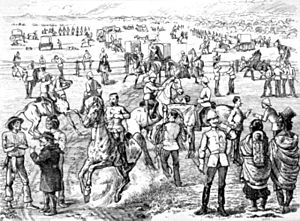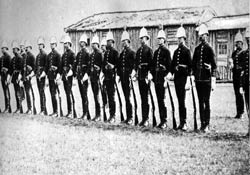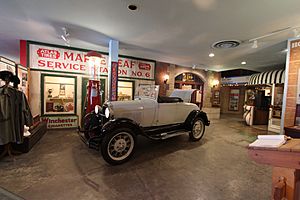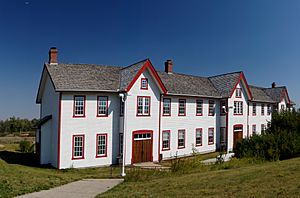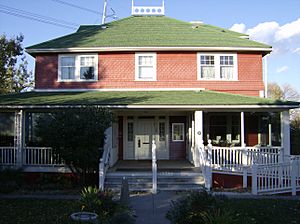Fort Calgary facts for kids
Quick facts for kids Fort Calgary |
|
|---|---|
| Native name Mohkinstsis; Wîchîspa; Guts'ists'i | |
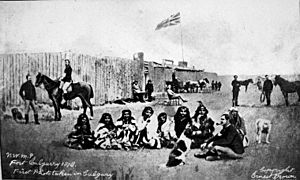
North-West Mounted Police with Kainai Nation members at Fort Calgary, 1878
|
|
| Etymology | Calgary House, a castle at Calgary Bay on the Isle of Mull, Scotland |
| Location | 750 9th Avenue SE Calgary, Alberta, Canada |
| Area | 12 hectares (30 acres) |
| Built | 1875 |
| Original use | North-West Mounted Police outpost |
| Demolished | 1914 |
| Current use | Museum, park, social centre |
| Governing body | Fort Calgary Preservation Society |
| Owner | City of Calgary |
| Official name: Fort Calgary National Historic Site of Canada | |
| Designated | 15 May 1925 |
Fort Calgary was an important outpost for the North-West Mounted Police (NWMP). It was built where the Bow and Elbow rivers meet in what is now Calgary, Alberta, Canada. The outpost was first called Fort Brisebois after its first commander. But in June 1876, its name was changed to Fort Calgary.
The fort was built in 1875. Its main goals were to stop illegal traders in the area and to build good relationships with the Indigenous peoples. In 1882, the fort became a "district post," which meant it grew bigger. The NWMP used Fort Calgary until 1914. Then, the land was sold to the Grand Trunk Pacific Railway, and the fort was taken down to build a train terminal.
Years later, in 1973, the city of Calgary bought the site. Work began on an interpretive centre in 1977. The site reopened as a historic place and museum in 1978. At first, the museum focused on the NWMP. But in 1995, its focus changed to the local history of Calgary. During the 1990s, some of the old buildings at Fort Calgary were rebuilt.
Contents
Why Fort Calgary Was Built
The spot where Fort Calgary was built, where the Bow and Elbow rivers meet, has always been a special gathering place. It is the traditional land of the Niitsitapi (Blackfoot Confederacy; Siksika, Kainai, Piikani), the îyârhe Nakoda (Chiniki, Bearspaw, Wesley), the Tsuut'ina people, and the Métis Nation, Region 3.
In the early 1870s, American traders were selling illegal goods to First Nations in the area. This illegal trade and American presence led the Canadian government to create the North-West Mounted Police (NWMP) in 1873. The NWMP's job was to show that Canada was in charge and to stop the illegal trade.
By 1874, the NWMP had mostly stopped the illegal traders. They started building forts in the area. They believed that if law enforcement was in place before settlers arrived, it would prevent the lawlessness seen in the American west. After Fort Macleod was built, traders moved their operations further away. So, in June 1875, a decision was made to build an NWMP outpost halfway between Fort Macleod and Fort Edmonton. "F" Troop, led by Éphrem-A. Brisebois, was given the task of building this new outpost.
Fort Calgary's Early Years
The I. G. Baker Company arrived at the site in July 1875 to build the NWMP outpost. The fort was first planned for a different spot. But Commander Brisebois chose to build it near the meeting point of the Bow and Elbow rivers instead. Workers cut spruce and pine trees upstream and floated them down to the site.
The fort was surrounded by a wooden fence called a palisade. Inside, there were buildings like stables, barracks (where soldiers lived), a guard room, and storage areas. The fort was finished by December 1875 and cost the Canadian government C$2,476. It was first called the Bow River Fort. In December 1875, it was officially named Fort Brisebois. However, Brisebois' bosses felt he had misused his power by naming it after himself. So, in June 1876, they renamed it Fort Calgary. This name was suggested by James Macleod of the NWMP, who got the name from Calgary House in Scotland.
Life at the outpost was tough at first. The buildings were not well heated or insulated. This led to poor living conditions for the police officers. Because of Brisebois' poor leadership, members of "F" Troop complained to headquarters in Fort Macleod in the winter of 1875–76. Brisebois was eventually replaced by Lawrence Herchmer in August 1876.
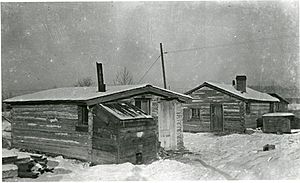
The I. G. Baker Company set up a trading post and storehouse near the fort. This brought more business to the area. The Hudson's Bay Company also moved its trading post closer to Fort Calgary. A mission also started near the fort but later moved. By 1877, a permanent church was built. In the late 1870s, the area became a popular stop for travelers going from Fort Benton, Montana to Fort Edmonton.
Growth and Demolition
By 1880, the need for a strong fort lessened as the illegal trade declined. The number of police officers at the fort dropped to four. However, this changed in the early 1880s. Plans were made to develop the area around Fort Calgary. In August 1882, the outpost was made a "district post" again. More police officers were sent to provide a permanent presence and enforce laws for the Canadian Pacific Railway nearby.
James Walker, a former NWMP member, was hired to expand the outpost. This expansion included new barracks, a guardroom with 12 cells, a hospital, officers' quarters, and facilities for tradesmen. To make room, the fort's wooden palisades were taken down, and some older buildings were removed. The expansion cost about C$35,000.
From 1882 to 1902, many changes were made to the site as buildings were added or removed to meet new needs. Police operations at the fort ended in 1914. The Grand Trunk Pacific Railway bought the site for C$250,000. All the remaining fort buildings were taken down to build a train terminal.
Fort Calgary Today
On May 15, 1925, the land where Fort Calgary once stood was named a National Historic Site of Canada.
In 1973, the city of Calgary bought the site to turn it into a historic park. An archaeological study began to find the exact location of the demolished fort. In 1975, during Calgary's 100th anniversary, archaeologists found parts of the original wooden fort and its artifacts. But they had to quickly re-cover them because they started to fall apart when exposed to the air.
After an interpretive centre was built in 1977, the site officially reopened as a historical museum in 1978. At first, the museum showed exhibits about the NWMP. In 1995, the museum's focus changed to the history of Calgary itself. During this time, reconstructions of Fort Calgary's stables and wagon shed were built. In 2000, a replica of the NWMP's two-story barracks was completed. After a report from the Truth and Reconciliation Commission of Canada in 2015, the museum began to include more Indigenous perspectives of the site.
From 2014 to 2020, the historic site went through a C$36 million expansion and restoration project. This included restoring the Deane House and Hunt House. The museum's interpretive centre was also renovated and expanded.
Exploring Fort Calgary's Grounds
Fort Calgary Historic Park is a 40-acre (16 ha) historic site. It sits on a grassy area along the south shore of the Bow River, near where it meets the Elbow River. The official National Historic Site of Canada area is about 12 hectares (30 acres).
The site has several rebuilt structures that were once part of the fort. These include the stables, a wagon shed, and barracks like the ones built in 1888. These reconstructed buildings were finished in the 1990s and 2000s. The interpretive centre, built in 1977, was expanded in the 2010s to 54,000 square feet (5,000 m2). Inside the barracks and interpretive centre, you can find exhibits and interactive displays about Calgary's history and the NWMP.
In 2016, an art installation called Marking was added to the site. It features vertical wooden slats with metal tops, placed along the outline of the original fort. The slats are about the same height as the fort's original palisades. From a certain angle, the slats look like 12 standing figures. At night, red lights illuminate the installation.
Important Nearby Landmarks
Fort Calgary is also close to two other historic buildings: the Deane House and the Hunt House. Their stories are connected to the fort's history.
The Deane House
The Deane House was built in 1906 near Fort Calgary for its superintendent, Captain Richard Burton Deane. He wrote about the house in his 1916 book, Mounted Police Life in Canada. The house was first built near 9th Avenue and 6th Street SE. Captain Deane felt the previous superintendent's house was not good enough for his wife. Even though the budget was $5,000, the house ended up costing $6,200.
In 1914, the Grand Trunk Pacific Railway bought the house and moved it to a different spot to use as an office. In 1929, C. L. Jacques bought the house and moved it across the Elbow River, where it stands today. For many years, it was used as a boarding house and was called Jasper Lodge. Later, it was renamed Gaspé Lodge.
In 1973, the city bought the building. It became a shared studio space for artists and writers, and an art gallery called the Dandelion Gallery. Today, the city still owns the house. It now has a restaurant called Deane House and has been renovated as part of the Fort Calgary upgrades.
The Hunt House
The Hunt House is the oldest building in Calgary that is still in its original location. It was built between 1876 and 1881 for Métis employees of the Hudson's Bay Company. It is located at 8th Street and 9th Avenue SE. The last person to live in the house was William Hunt, a rail worker, who passed away in the mid-1970s. In 1977, it became an Alberta Provincial Historic Resource. Another building, the Métis Cabin, thought to be built around the same time, was moved in the 1930s and recently moved back to its original spot.
Museum Affiliations
Fort Calgary is connected with several important organizations. These include the Canadian Museums Association, Canadian Heritage Information Network, and the Virtual Museum of Canada.
Images for kids


